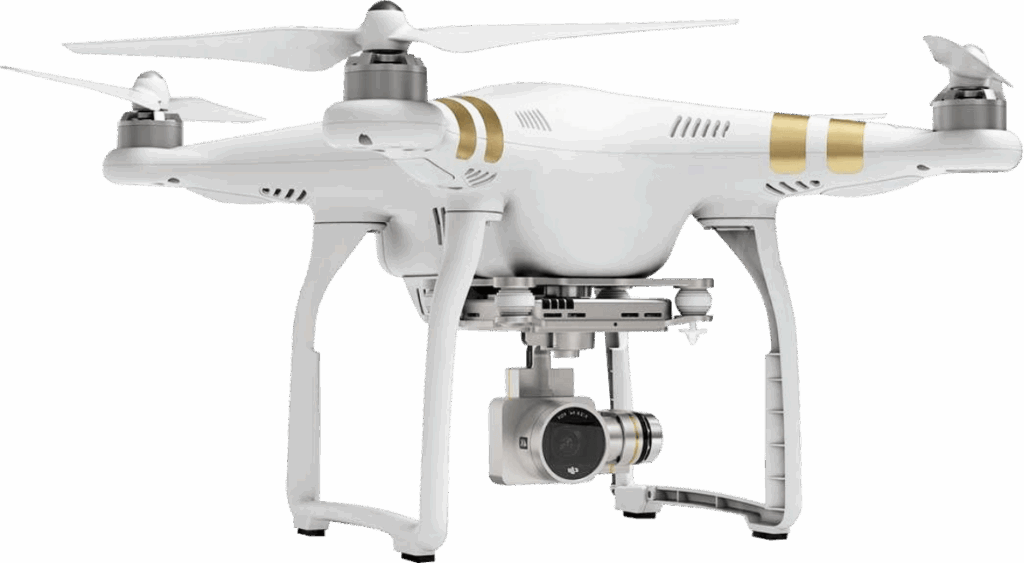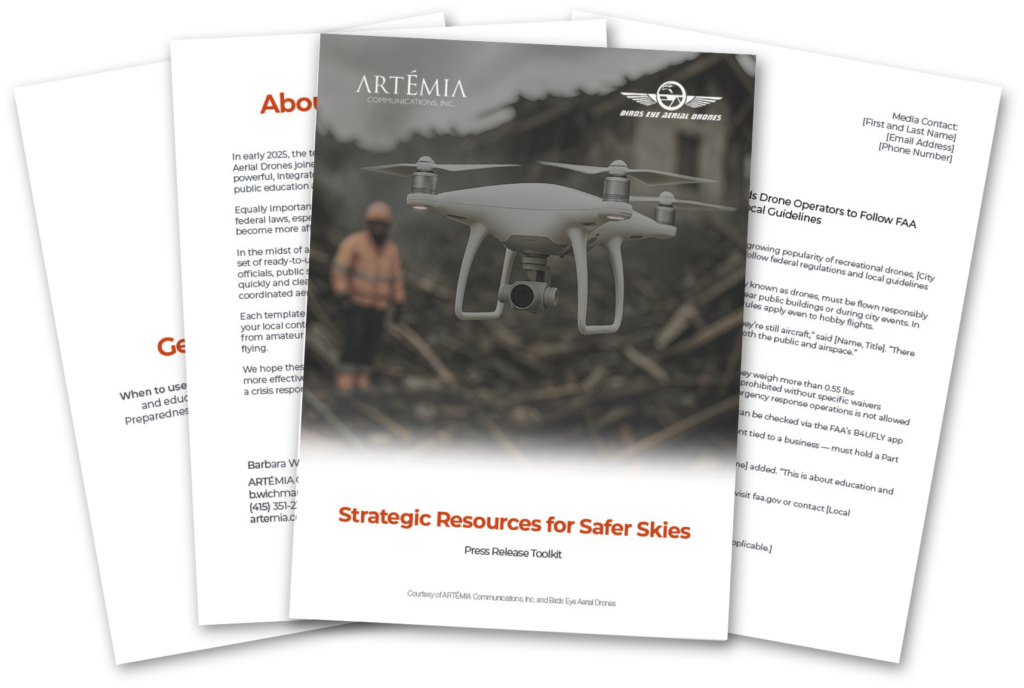Disaster Preparedness & Emergency Response Support
Aerial Intelligence Meets Strategic Communications for Safer, Smarter Communities

A Collaborative Approach to Airspace Safety & Community Engagement
From ARTÉMIA & Birds Eye Aerial Drones
ARTÉMIA Communications and Birds Eye Aerial Drones (BEAD) have joined forces to help agencies unite aerial intelligence with strategic communication. From public education and stakeholder coordination to real-time data collection and rapid response, our integrated support model is designed to help emergency managers improve incident response, prevent unauthorized UAS incursions and build lasting community trust in the use of emerging technologies.

Download the Free Toolkit
Keep your community informed and the skies safe with our press release tool kit.
Our Joint Capabilities
Our approach is grounded in a shared commitment to understanding local risks and dynamics, empowering emergency managers and public safety officials to mitigate vulnerabilities and educate the public before disater strikes.
Strategic Planning & Program Development
- Proactive communications and outreach planning to support UAS integration and public trust
- Development of Drone as a First Responder (DFR) program strategies and implementation roadmaps
- Stakeholder mapping, analysis, and engagement frameworks tailored to agency environments
- Policy and procedure development for authorized UAS operations and incident response
- Coordination with local, state and federal partners to ensure compliance with FAA and DHS guidance
- Funding and grant support, including proposal writing and documentation for DFR or preparedness programs
Public Education & Community Engagement
- Comprehensive public education campaigns on safe and responsible drone use
- Awareness initiatives to prevent unauthorized UAS activity during emergencies
- Community outreach events, demonstrations and safety workshops
- Bilingual and multicultural engagement strategies to reach diverse populations
- Development of educational materials such as flyers, PSAs, social media and school programs
- Collaboration with civic organizations, schools, and media to expand reach and reinforce key messages
- Public listening sessions and feedback channels to strengthen transparency and trust
Operational Support & Rapid Response
- Deployment of FAA Part 107-certified pilots for aerial imaging, mapping and situational awareness
- Rapid response aerial support during active incidents (wildfires, floods, infrastructure damage, SAR, etc.)
- Real-time data capture and distribution to assist command decisions and ground coordination
- Post-incident documentation, analysis, and visual assessment to inform recovery and reporting
- UAS integration support within Emergency Operations Centers (EOC) and Incident Command Systems (ICS)
- Development of unauthorized UAS response protocols and coordination playbooks
Training & Capacity Building
- UAS pilot and operator training programs (Part 107 prep, operational best practices, safety procedures)
- Internal communications and media training for agency spokespeople and PIOs
- Community engagement and crisis communication training for agency teams
- Cross-agency workshops to strengthen interoperability and messaging consistency
- Tabletop exercises and scenario-based simulations integrating UAS and communications components
Program Communications & Media Relations
- Creation of strategic communications plans for new or existing UAS programs
- Messaging development to communicate safety, benefits, and accountability
- Media strategy and press coordination for public announcements or incident briefings
- Development of visual and digital content, including videos, infographics, and drone footage for public education
- Social media management and monitoring during incidents to maintain situational accuracy and counter misinformation
- Crisis communication support to manage public concern following unauthorized drone activity or safety incidents
Data, Reporting & Evaluation
- Collection and analysis of engagement metrics and community feedback
- GIS and mapping visualization for stakeholder briefings and after-action reviews
- Development of performance dashboards and reports demonstrating outreach effectiveness

The Value We Bring
Our approach is grounded in a shared commitment to understanding local risks and dynamics, empowering emergency managers and public safety officials to mitigate vulnerabilities and educate the public before disater strikes.
- Strengthen UAS programs with both operational and communication capacity
- Prevent disruptions through proactive public education and deterrence strategies
- Respond quickly and effectively to both emergencies and unauthorized activity
- Align internal teams, interagency partners and community stakeholders
- Build programs that are not only compliant, but credible and supported
Ready to Get Started?
Frequently Asked Questions
How does the ARTÉMIA and BEAD partnership help public safety agencies with limited resources?
We provide an end-to-end support model that extends your team’s capacity in critical areas like public outreach, crisis communications, and rapid response.
BEAD delivers FAA Part 107-certified aerial operations, real-time data, and incident mapping, while ARTÉMIA leads strategic communications, stakeholder engagement, and media coordination, helping your agency operate efficiently without adding internal burden.
What types of incidents and operations can your UAS support?
Our team supports a broad range of public safety and emergency management missions, including wildfires, floods, search and rescue operations, infrastructure assessments and post-disaster recovery. We also assist with Drone as a First Responder (DFR) programs, preparedness planning and ongoing community awareness campaigns.
How do you help prevent unauthorized drones during emergencies?
We develop public education campaigns and communication toolkits to deter unauthorized UAS activity near disaster zones, wildfires and emergency operations. This includes safety PSAs, social media assets and coordination protocols that align with FAA and DHS guidance, helping agencies minimize disruptions and protect responders.
Can you help agencies communicate about their UAS programs to the public?
Yes. We design and implement public education and stakeholder engagement strategies that highlight the safety, accountability and benefits of UAS programs. From message development and media relations to community events and school outreach, we help agencies build understanding and support for their operations.
Do you assist with grant strategy and documentation for UAS programs?
Yes. We help agencies strengthen their Drone as a First Responder (DFR) or emergency preparedness proposals through grant strategy, documentation and reporting support. Our team assists with funding narratives, technical descriptions and compliance documentation to ensure submissions align with federal, state and local requirements.
What training options are available for agency staff?
We offer customized training programs for pilots, PIOs and emergency management teams, including Part 107 preparation, operational best practices, crisis communication and cross-agency coordination exercises to enhance readiness and interoperability.
How do you ensure compliance with FAA and DHS regulations?
All BEAD flight operations adhere to FAA Part 107 and public safety authorizations. ARTÉMIA complements this by ensuring that agency communications, documentation and outreach meet FAA and DHS guidance, reinforcing both operational safety and transparency.
Can you help launch or expand our existing UAS program?
Absolutely. We support agencies at every stage, from establishing a new public safety drone program to optimizing existing operations. Our team develops implementation roadmaps, communication frameworks and engagement strategies that make UAS programs sustainable, compliant and community supported.